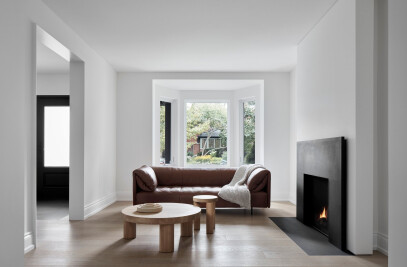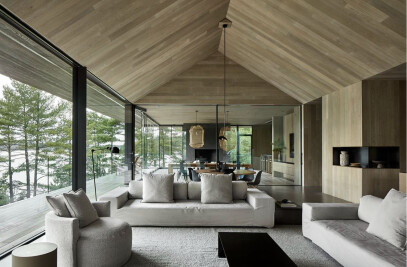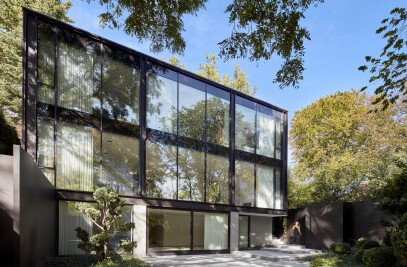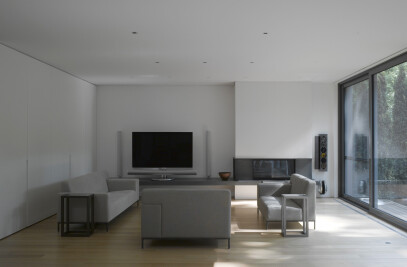Pointe Au Baril is among the most dramatic freshwater landscapes in Canada. Located three hours north of Toronto, it is known for its many Precambrian rock archipelagoes scattered along the coast of Georgian Bay, forming narrow waterways that even experienced boaters find challenging to navigate. The region attracts permanent and seasonal residents who share a profound respect for its untouched beauty.



Whistling Wind Island is one of the furthest islands from the mainland to be inhabited. Surrounded by open waters and expansive sky, it is continually exposed to changing water levels and mercurial weather patterns where morning sunshine can change to unexpected hail storms by the afternoon. The robust wind conditions make Pointe Au Baril the ideal location for the owner to enjoy his passion for kite surfing.


The cottage comprises a cluster of buildings, each scaled proportionately to the island's one-acre size. Four pitch-roofed structures, harmoniously clad in silver-weathered cedar shingles, appear as though tossed around by the wind. In certain light conditions, they are barely discernible from the brownish-grey rocks surrounding them. The main cottage is at the highest elevation. A bunkie, a sauna, and a boat storage containing a small fitness room are located on different outcroppings and reachable via wooden plank gangways that link to boat landings and fill gaps between rocks.

Unlike many summer homes sited in favour of one vista, the cottage and bunkie are surrounded on most sides by wrap-around decks for taking in panoramic views in every direction. Their asymmetric shapes fan out over the terrain with steps angled in harmony with the natural topology of the sediment rock. There is very little sense of front and back entry points. Triple-pane operable glass walls dissolve a traditional orientation by providing multiple ways to move with ease between indoors and out. Retracting walls also provide natural thermal control with cross breezes cooling the interior. Deeply recessed windows punctuate the façade, with overhangs that are carved into the mass of the building which provide shade from the high summer sun and help to reduce solar heat gain.


Natural materiality
The main room of the cottage is comprised of an open kitchen, a generous dining area and a living room featuring a full-height fireplace wall made of local Muskoka granite slabs. Custom-made cedar whitewashed boards on the walls run horizontally to echo the continual presence of the location's dominant water and sky horizon line. Matching wood planks line the cathedral ceiling, providing a contemporary interpretation of a gabled wood form found in traditional cottages.

The same material application is used in the bunkie, giving both interiors the warmth of being fully enveloped by natural wood walls, ceilings and floors. Likewise, the exterior of each building is continuously clad on the roof and walls with Western Red Cedar shakes, creating a stereotomic reading of each form from which the windows and interior volumes appear to have been carved out of an otherwise solid mass. The visual solidity of these buildings fosters comfort in knowing these dwellings can withstand the extreme weather patterns of nature, while the modest scale and tactile warmth of the interiors provide a cozy refuge that is experienced most intensely when the sun sets. Given the large windows, the building interiors are ideal for watching the dramatic summer storms that are characteristic of Pointe Au Baril.

At 1,800 square feet, the main cottage houses two bedrooms, a shared ensuite bathroom, and a laundry room in addition to the communal kitchen, dining and living areas. The bunkie is a smaller version of the cottage, designed to sleep up to four in two bedrooms with a shared bathroom. A large flagstone fireplace at its core separates the bedrooms from a kitchenette with desk and lounge area with a pair of loveseats. While woodburning fireplaces in both indulge the sensation of elemental living, they are also the sole heat source, eliminating the need for mechanical backup systems.

In sync with Nature
Whistling Wind Island rigorously addresses the challenges of building sustainably. The two primary residents are built upon the original footprints of preexisting structures. Triple-pane operable glass walls provide natural thermal control while deeply recessed windows punctuate the façade. Overhangs carved into the mass of the building provide shade and reduce solar heat gain, while woodburning fireplaces in both buildings eliminate the need for mechanical backup systems.

Water usage is also kept to a minimum, with low-flow plumbing fixtures and the only “bathtub” being Georgian Bay itself. A tankless, on-demand hot water system for the dishwasher and laundry reduces the amount of water required, and shortly, an outdoor shower will provide another lake-water bathing option. The lighting fixtures were selected to mimic the soft mood of candlelight and exterior lighting was eliminated altogether, in respect to the night sky and the moon’s reflection on the water. The interior glow is enough to illuminate the surrounding decks.

The cottaging season in Pointe Au Baril is short-lived as it is governed by the months in which the islands can be accessed by boat. By November, the ice begins to form on the lake, bringing the season to a close. In order to protect the buildings through the harsh winter months, recessed aluminum garage-like doors roll down to cover the windows and the floating docks are removed from the water.

Cottage: 1800 sf
Bunkie: 970 sf
Sauna: 95 sf
Boat storage and fitness room: 265 sf
Island: one acre
Credits
Architecture team: Kelly Buffey, Robert Kastelic, Donald Peckover, Byron White, Tim Wat, Antonio Morais, Nicole Rak
Whistling Wind Island
Location: Pointe Au Baril, Ontario, Canada
Architects: Akb Architects
Completion: 2023
























































